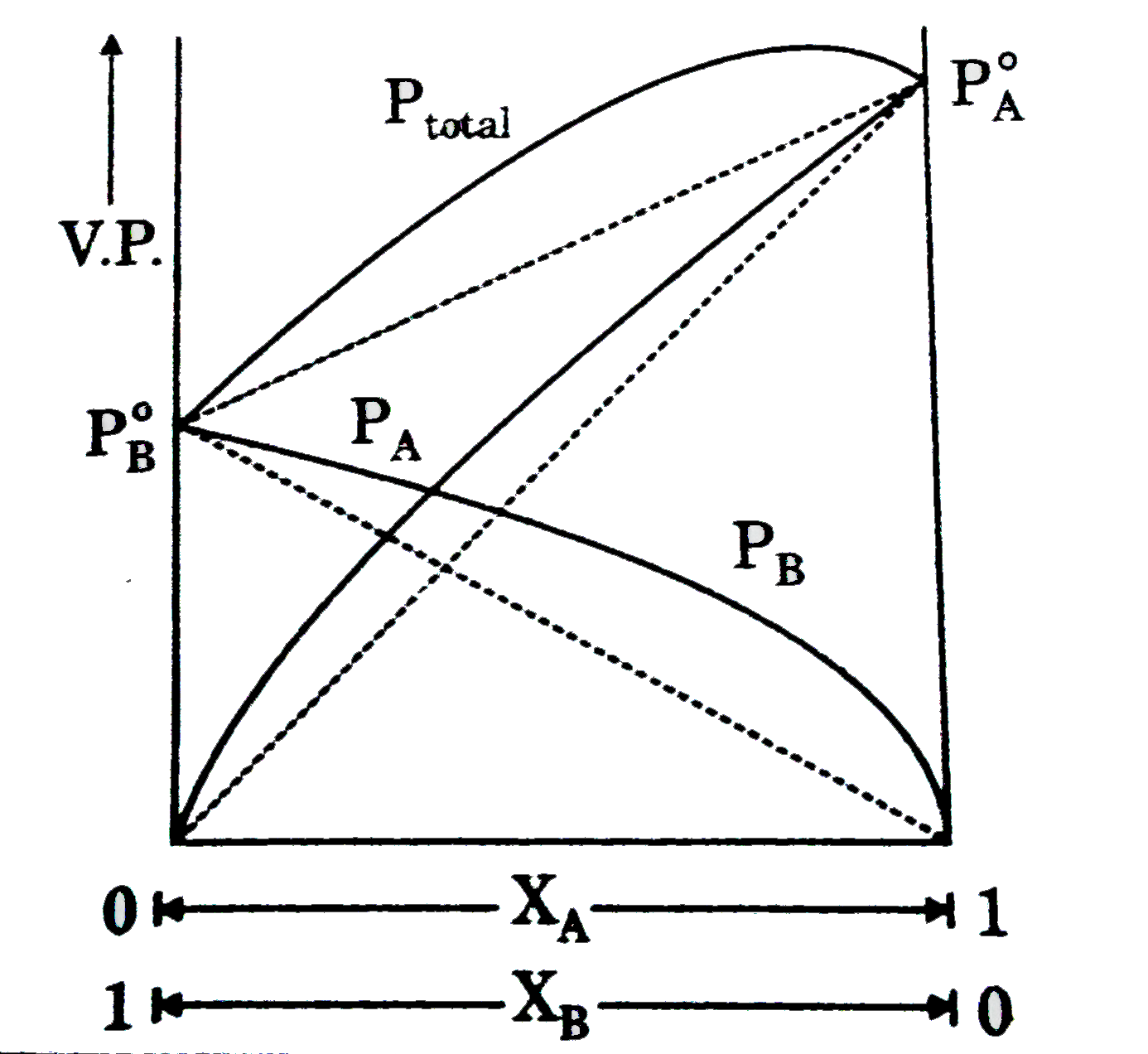Answer the question (given below) which are based on the following diagra. 
Consider some facts about the above phase diagram :
Vapour pressure diagram for real solutions of two liquids A and B that exhibit a positive deviation from Raoult's law. The vapour pressure of both A and B are greater than predicted by Raoult's law. The dashed lines lines represented the plots for ideal solutions.
Total vapour pressure of mixture of 1 mol of volatile component A(P∘A=100mmHg) and 3 mol of volatile component B(P∘B=60mmHg) is 75mm. For such case:
A
There is positive deviation from Raoult's law
B
Boiling point has been lowered
C
Force of attraction between A and B is smaller than that between A and A or between B and B.
D
All the above statements are correct.
Video Solution
Text Solution
The correct Answer is:D
XAPA0+XAPA0=14×100+34×60=70mmofHg
Now PA+PB>XAP(A0)+XBPB0
i.e., positive deviation from Raoult's law.
for positive deviation.
B.P.< expected value
FA...B<FA...A
FA...B<FB...B
|
Topper's Solved these Questions
- SOLUTIONSBOOK - RESONANCECHAPTER - SOLUTIONSEXERCISE - EXERCISE-3(PART-1)
14 Videos
- SOLUTIONSBOOK - RESONANCECHAPTER - SOLUTIONSEXERCISE - EXERCISE-3(PART-2)
16 Videos
- SOLUTIONSBOOK - RESONANCECHAPTER - SOLUTIONSEXERCISE - EXERCISE-2(PART-2)
37 Videos
- SOLUTION AND COLLIGATIVE PROPERTIESBOOK - RESONANCECHAPTER - SOLUTION AND COLLIGATIVE PROPERTIESEXERCISE - PHYSICAL CHEMITRY (SOLUTION & COLLIGATIVE PROPERTIES)
52 Videos
- STEREOISOMERISMBOOK - RESONANCECHAPTER - STEREOISOMERISMEXERCISE - EXERCISE (PART III : PRACTICE TEST-2 (IIT-JEE (ADVANCED PATTERN))
22 Videos
Similar Questions
Knowledge Check
Answer the questions (given below) which are based on the following diagram: vapour pessure diagram for real solution of two liquids A and B that exhibit a negative deviation from Raoult's law. The vapour pressure of both A and B are less than predicted by Raoult's law. The dashed lines represent the plots for ideal solutions.

Solution containing components A and B show this type of deviation from ideal behaviour when:AAttractionA...BΔHmixΔVmixB.PLarger than average ofA...A.B..Battraction+ve+velarger than expectedBAttractionA...BΔHmixΔVmixB.PAs in(a)−ve−veAs in(a)CAttractionA...BΔHmixΔVmixB.PSmaller than average ofA...A..B..Battraction+ve+veSmaller than expectedDAttractionA...BΔHmixΔVmixB.PAs in(c)−ve−veAs in(c)Answer the question (given below) which are based on the following diagra.

Consider some facts about the above phase diagram :
Vapour pressure diagram for real solutions of two liquids A and B that exhibit a positive deviation from Raoult's law. The vapour pressure of both A and B are greater than predicted by Raoult's law. The dashed lines lines represented the plots for ideal solutions.
A: This is observed when A...B attraction are greater than average of A...B and B...B attraction:
B: ΔHmix=+ve,ΔVmix=+ve
C: Boiling point is smaller than expected such that vaporisation is increased
D: Mixture is called azeotropic mixture
Select correct factsAA,B,CBB,C,DCA,C,DDA,B,C,DAnswer the questions (given below) which are based on the following diagram ?

Consider some facts about the above phase diagram. Vapour pressure diagram for real solutions of two liquids A and B that exhibit a positive deviation from Raoult's law. The vapour presssure of both A and B are greater than predicted by Raoult's law. The dashed lines represented the plots for ideal solutions.
A : This is obserbed when A...B attractions are greater than average of A...B and B.....B attraction :
B : ΔHmix=+ve,ΔVmix=+ve
C : Boiling point is smaller than expected such that vaporisation is increased
D : Mixture can from azeotropic mixture Select correct facts.AA,B,CBB,C,DCA,C,DDA,B,C,D
Which liquids pair shows a positive deviation from Raoult's law?
View SolutionWhich of the following liquid pairs shows a positive deviation from Raoult's law?
View SolutionWhich of the following liquid pairs shows a positive deviation from Raoult's law?
View SolutionSolutions showing negative deviations from Raoult's law
View SolutionWhich of the following liquid pairs shows a postive deviation from Raoult's law ?
View Solution